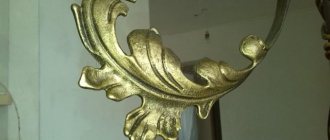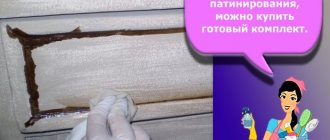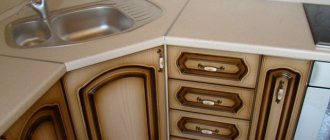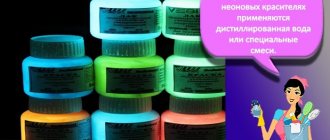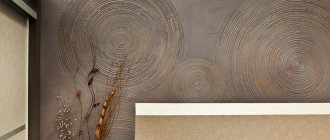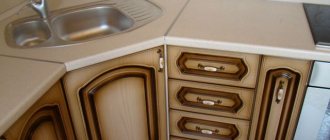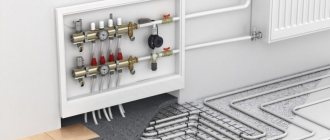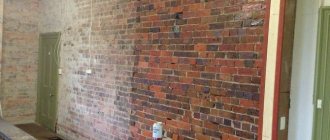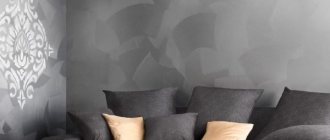Applying patina to metal and wood products
Patina is a special paint that allows you to give a metal or wooden surface an aged, noble look. The meaning of the word “patina” has nothing to do with paints. The term refers to a thin film that forms on a metal surface after prolonged interaction with oxygen.
The process of film formation on metal has been known since ancient times. Previously, this process was called bluing. However, bluing has a number of serious disadvantages:
- This is a complex technology and it is not easy to repeat it with your own hands;
- the cost of bluing is high;
- the process takes a lot of time.
Modern paints make it possible to paint a surface (not only metal, but also wood) much faster - within a few minutes. At the same time, the quality of the material is completely preserved.
How can you patina metal?
Paint it. Use a coloring compound to give the metal surface the desired color. It is advisable to use patina in powder form - it has good adhesion to surfaces and lasts quite a long time.
Carry out a chemical reaction. Metal can be patinated using different chemical compounds - for example, oxidizing agents, acids, solvents. Or using thermal influence. But such a technique requires strict adherence to safety rules and can give unpredictable results.
Color solutions
The most common type of patina is copper oxide. The surface painted with this paint has a greenish appearance. On other metals, oxidation processes occur differently, so patina gives different colors, for example:
- on steel - ocher or yellow;
- on bronze and brass - brown;
- on silver - darkish gray.
In construction supermarkets you can buy patina in a variety of colors:
- like silver;
- under natural copper;
- under gold;
- green copper oxide.
These are the most common colors, however, paints with more exotic shades are also available. Such paints do not imitate any metal, but are an independent color scheme. Their use is usually associated only with the desire to give the surface an antique look.
As an example, the following colors can be given:
How to patina copper?
How to patina copper so that the product acquires an antique effect? One of the popular remedies is acetic acid or ammonia vapor. Copper wire or plate at a temperature of 20-25 degrees quickly comes into contact with chemical fumes and forms a coating. You can speed up the process and increase the intensity of patination by increasing the air temperature in the area of the procedure.
To create a patina, the product should be placed in an airtight container with ammonia or acetic acid poured into the bottom (follow safety precautions, work with gloves, you must also hold your breath or use a respirator). Follow the process; the decoration will begin to turn brown. Do not overexpose so as not to increase fragility and damage the metal).
Remove the product after reaching the desired color intensity and rinse with water. Using a velvet cloth with polishing paste (goyi paste), polish the jewelry, brush, rinse again and dry.
Application technology
The principles of patination of metal and wood are different. Powder (forge) patina is used for metal, and acrylic patina is used for wood.
Acrylic patina
This paint is almost never used on metal surfaces. The reason is poor adhesive properties. However, acrylic is perfect for painting wooden products, as it penetrates deeply into the pores of wood and emphasizes the beauty of its fibers and structure. Wood painted with acrylic patina takes on a noble appearance, its appearance is enriched with color transitions.
Note! It is not recommended to apply patina to furniture made in a modern style. Furniture painted this way will not look aesthetically pleasing.
Patina painting is often used for items made in the following styles:
The acrylic patina coating technology is called abrasion. Aging consists of first applying a layer of paint, which will act as a so-called substrate.
- Before painting, the surface is thoroughly but gently cleaned with a wire brush or coarse sandpaper. In this case, part of the surface is removed, and the structure of the tree becomes more obvious. You need to sand the wood in such a way that the movements are directed along the structure and only in one direction. This will show the texture without compromising the integrity of the wood.
- The next step is to apply a thick layer of acrylic patina. Next, you need to wait a few minutes until the material penetrates the wood. At the same time, you need to remember: the longer the pause, the darker the painted product will ultimately be.
- Excess paint is removed with a sponge or soft rag.
- After the paint has dried, you can make the color more saturated by applying an additional layer of paint material. You can also varnish the surface.
What does it mean to “patina” a product?
What does “patina” mean in terminology? This means coating metal products with a special coating that will give the item an antique appearance. Metal products can be patinated using chemical compounds, solutions, vapors, after contact with which the product changes color and becomes special.
The film that forms on the product after the patination process is protective and, when used, protects the metal from environmental influences and external aggressive conditions.
Various natural shades of patina on copper products are known. Green, olive, blue, brown, reddish, close to black. These colors appear on copper and copper-containing alloys - brass and bronze. The patina that forms naturally on metal looks beautiful and even has the epithet “noble”.
Aesthetic and practical effects prompted jewelers and decorators to invent ways to create artificial patina as a way of aging a product. There are two ways to patina metal: random and stable.
With a stable method, the result of patination can be accurately calculated. For example, if you use liver sulfur, the coating will turn out to be brown in color; the degree of its saturation can be adjusted by exposure time.
With a random method of applying patina, the result cannot be predicted, since it will depend on how the metal behaves in reaction to certain agents. But this method always produces an interesting and artistically valuable result.
There are a variety of agents and reagents available for plaque formation. Let's consider the most popular ones for patination of copper and brass.
Powder patina
The first type of powder patina is considered to be silver. It is basically a powder that must be mixed with drying oil before use. How to properly breed silverfish, read in this material.
The color of blacksmith's paints is usually matte, and the patina gives the metal a noble shine. You can purchase powder material in the form of a finished product. For greater convenience when painting, the patina can be mixed with xylene or solvent.
Note! To paint metal products, it is recommended to purchase special material for blacksmithing.
Covering with blacksmith's patina is considered quite a difficult task in the absence of the necessary experience. To apply paint you will need something like a palette where you can smear the paint material.
- Clumps of patina should be placed on one side of the palette.
- Lightly wet the brushes in solvent or xylene. Then rub the paint until the brush is completely dry.
- Next, the paint is applied with careful strokes. The product should only be touched with the tip of the brush. The result should be an uneven layer of paint and something resembling scuff marks.
The process is very labor-intensive and time-consuming. Although the result is worth it - the product will take on a noble, aged appearance.
Due to inexperience, many people try to take as much patina as possible onto the brush to avoid rubbing it after a couple of strokes. However, it is strictly not recommended to do this, since in this case it will not be possible to achieve the desired result.
So, working with patina requires certain skills, so it is difficult for a beginner to count on quick success. It is recommended that you first use objects for patination that you don’t mind spoiling. After gaining experience, you can take on more responsible work.
How to change the color of metal?
How to change the color of metal to make it look like antique? Since time immemorial, craftsmen have used the methods of oxidation, bluing and patination.
Various methods are used to carry out the work:
- Metal processing over an open fire . This method is one of the most popular and ancient among jewelers. For a more beautiful and even color, it is recommended to calcinate the wire over an open fire in advance, even before creating the decoration. This is due to the fact that the heating rate of the metal may differ in different areas, therefore, there is a danger of burning it out and making it brittle. In addition, if the original working metal is varnished, the fire will remove it and pre-prepare the wire for work.
- Treating metal with a sulfur liver creates a patination effect. Typically a proportion of 50 ml of water/1 drop of product is used. It is recommended to use water at 20-23 degrees, close to room temperature, since with hotter water the patination reaction occurs faster, and the resulting patina becomes less stable and will begin to wear off when it touches clothing, skin, or the surface of the box.
- Ammonia solution (in the first case, exclusively its vapors are used). To process, place the decoration in a jar with a lid, into which pour 1 ml of ammonia of 5% concentration. The color of the metal changes relatively quickly; it can be adjusted by observing the changes over time.
- Ammonia solution (in the second case it is used together with water). For processing, the product is sprayed with water or placed directly into the solution for 1 second, and then it is sent to a container where ammonia vapor is formed. Under the influence of water and ammonia in steam, the color of the patina becomes close to blue.
Patination or how to age metal (from here)
Patination is a technique for “aging” the surface of metal or wood, which is achieved by applying dyes based on various acids. As a result, the products acquire a special charm and the spirit of antiquity. Before carrying out manipulations, working surfaces are put in order, then treated with a special primer from a spray can, which allows the paint to better adhere to the surface. Patination of metal requires time and patience; we will look further at how to apply patina paint to the surface and what effect can be achieved.
What is forging patination
Patination is the process of artificially aging a forged element; this effect can be achieved in several ways.
At the dawn of the development of artistic forging as an art, patination was carried out mainly by exposing the metal to various chemical and mechanical methods. These methods, in addition to their undeniable advantages (the acquisition of metal as a result of processing a stylized antique design), also had a number of significant disadvantages:
- the reagents used by craftsmen when using chemical patination methods sooner or later corroded the metal, which led to a sharp deterioration in its properties;
- As a result of mechanical influences, the metal lost its shape, as a result of which both the appearance of the product and its positive properties deteriorated.
Modern specialists in artistic forging mostly prefer other methods. We will talk about the technology of the most popular of them - applying special paint to metal - in this article.
What you need for work
The very meaning of the word “patina” has nothing to do with the dyeing process. It is of Italian origin and refers to the film that forms on metal after prolonged interaction with oxygen.
Initially, you had to wait a long time for the metal to oxidize itself, and the result was completely unpredictable; now this technique can be reproduced at home with your own hands using the following materials:
- patina of the color you like (in powder);
- liquid solvent;
- brush (size 2-3) or sponge;
- small plastic or glass trays (do not take metal ones, they can interact with the paint);
- metal product that you want to decorate.
Pay attention to safety precautions! Means for patination involve working with chemical oxidizing agents, solvents and require special care.
It is recommended not to work in confined spaces without respiratory protection. It is better to work in the fresh air, in rooms with good ventilation (with open windows, an exhaust fan on, a draft). If acid gets on the surface of the skin, immediately rinse under running water and then apply a paste of baking soda. If rashes, burns or any skin changes occur, consult a doctor immediately!
Metal blackening
The use of dark patina makes forged products more weighty and massive, making them look expensive and luxurious. To achieve this effect, after completing the forging process, the scale is removed with sandpaper, and the surface undergoes a cleaning and grinding procedure using a special paste.
The simplest technology for blackening metal involves the use of vegetable oil. The product is placed on a stand and subjected to gradual and uniform firing. As a result of this operation, a dark brown or black color appears on the surface of the structure, which is fixed with mastic.
Patination colors
On different metal surfaces, completely different color schemes can be achieved by patination. The most common patina color is greenish, which is produced by the oxidation of copper. On other metal surfaces, the resulting shade may be completely different:
- Rich yellow or ocher color on steel surfaces.
- Chocolate brown on brass and bronze items.
- Dark gray on silver items.
The choice of dry patina for metal work is quite varied. Powder is sold in almost every hardware store. Most common colors:
- aged silver;
- natural or oxidized copper;
- red gold.
Brighter radical colors are also available, for example, blue, lilac, red, allowing you to achieve an original effect on the surface of various metals.
What is patina?
Before learning how to change the color of metal, it will be helpful to know what patina is. Patina (from the Italian patina) is a coating that forms on copper products or products made from alloys using copper. Patina is always multi-layered, but on the surface there is only a green-blue or brown layer visible to the eye.
There is an artificial patina, which is created specifically by treating the metal with various chemical compounds; and natural, which forms on the product over time and is an oxidation reaction under the influence of storage and maintenance conditions.
Patina, formed naturally, can be seen on ancient copper coins, monuments, gates, castles, and temple domes. The metal is covered with a film of dark brown to bluish-green shades, which is a kind of protective layer of the base metal.
Surface preparation
Decorative application of patina requires careful preparation of the surface being treated; the metal must be perfectly smooth. There should be no signs of corrosion on it; it will not allow the surface to be well primed; the top layers will quickly bubble and peel off.
All burrs must be removed, chips and potholes must be filled and sanded with sandpaper (first coarse, then finer).
The prepared product is coated with a special primer (most conveniently, from a spray can), and then metal patina paint is applied to it.
Please note that the patina effect looks best on items painted with dark, especially black paint. The painted product must dry well, otherwise the patina will not adhere well and you will not achieve the desired effect.
How to paint metal for patina
Before patination of metal, you need to carefully prepare its surface. If you apply patina to unprepared metal, it will quickly lose the brightness of its color, will be applied unevenly and, as a result, will not give the desired effect. To prepare the metal, remove chips, fill and sand potholes, and coat it with a special primer. If you want to achieve a multi-faceted effect, cover the metal with a coat of paint in a base color. The patina will look best on items that are black or another dark shade.
You can age metal using a sponge or brush. To start patination, dilute the powder in a plastic container, put on rubber gloves and start painting.
If you are working with a brush , carefully dip the tip into the paint and apply the patina in small strokes. There is no need to wet the brush - the water will cause drops or streaks on the metal being processed. Use different strokes to achieve different textures and richness of color.
If you are working with a sponge , also do not wet it or press it hard against the surface. Otherwise, the patina will be imprinted along with the pores. Sponge treatment gives a noble dusting effect.
Keep the solvent nearby - if you make a mistake, you can quickly remove the patina layer and apply a new one. It is also advisable to keep the base color paint nearby - if the solvent removes it too, you can easily restore the shade. But keep in mind that the paint layer on the metal must be completely dry before patination.
Patination of metal with paint is the most accessible method at home. For example, in just a day you can get an excellent bronze aging effect using two shades.
Patina paint application technique
There are two ways to age metal: applying patina with a brush or sponge. By placing dissolved paint on the tip of a brush, you can achieve completely different textures, directional strokes and different depths of paint. Do not wet the brush before starting work; it must be dry; a wet brush will cause smudges and drops on the metal being processed.
Do not take a brush that is too large or small - the optimal bristle size is 2-3 cm. The sponge gives a “dusty” effect, but do not press it too hard, otherwise pores will be imprinted on the surface being treated.
Keep a napkin with solvent and some of the base paint with which the product is painted at the ready. Working with the patina should be virtually error-free. Repeatedly applying patina to metal in the same place gives an unsightly “flat” effect. When painting individual elements, be careful: if you accidentally “smeared” something nearby, simply paint over this area with background paint.
On video: applying patina to metal.
Features of application to forged products
The easiest way to age forged products is to paint with metallized substances and patination coatings. It is permissible to apply crackle effect varnish on top of the base layer. It will imitate small cracks and make the surface more decorative.
To achieve a beautiful effect, the product must be cleaned of dirt and rust. Then it should be covered with a layer of primer. Metallic compounds are recommended to be applied with a brush. To create signs of aging, foam swabs and dry brushes are suitable.
Patination of metal with oxidizing agents
Obtaining a patina on metal by immersing it in various chemical compounds is a labor-intensive method, which will result in the formation of a colored film (patina) on the surface of the metal. This type is much more durable, since the film does not wear off quickly under mechanical stress, like paint. If you want to feel creative and try to age metal using patination solutions, you will need special chemicals.
The surface to be treated should be prepared, as when working with paint, but not primed or painted, but degreased and bleached in an acid solution. You can carry out all the manipulations at home, create a masterpiece with your own hands or give new life to old objects.
How to do classic patination at home and get the colors you want? When patinaing brass, the most common colors sought are black or deep brown, olive, dark orange, or mouse gray. The brown color is achieved by immersing the metal in a solution of sodium thio-sulfite, popularly known as photofix.
An acid (sulfuric, hydrochloric, nitric) is first added to the prepared solution and the metal is lowered into it. Do not overexpose the product! The patina will appear very quickly. Work carefully! Use rubber gloves and take short breaks every 15-20 minutes.
Important! The coating is not very durable; it must be coated with varnish on top.
How to get other shades:
- To obtain an olive tint, brass products are immersed in a solution consisting of ammonia, water and chlorinated copper oxide (in a ratio of 4/5/2). Be very careful - the composition is toxic.
- A thick orange tint on brass will be given by a mixture of potassium sulfite, and a gray gray tint will be produced by liver of sulfur (a sintered mixture of sulfur 5 g in powder and potash).
- On copper, as on brass, the patina is very impressive. You can get a black tint on it (when immersed in sulfuric liver solution) and ancient blackness (if you mix 2-3 g of sulfuric liver, add the same amount of ordinary salt).
- Copper sulfate together with zinc chloride will give a blood-red patina.
- The luxurious blue color of steel will be given by a mixture of hyposulfite and acetic acid lead (150 g plus 50 g per 1 liter of water). The patina on steel appears both when immersed in a cold solution and when it boils (the shade will be more saturated).
- You can achieve a raven wing shade (“bluing”) by immersing the product in a chromium solution at the rate of 100 g per liter of water. The steel will acquire an amazing metallic glow with a deep, black-blue tint. After about 20 minutes, the steel will be covered with a film of an amazing blue-black hue.
- When bronze items are patinated, they acquire various shades of green and blue. To obtain a light green tint you will need 3 parts aluminum chloride, 1.5 5% vinegar and 5 copper salts. The exposure time of the desired shade on bronze is determined visually. The longer the exposure, the deeper and darker the resulting shade will be.
Available effects on metals
Metal objects are not so often found in apartments. However, with the help of such elements it is possible to create a unique design. Their functions can be performed by candlesticks, lamps, chandeliers. Such products have an attractive appearance. However, in some interiors they want to give a special antique effect. For this purpose, the patination technique is used. With its help, you can achieve different results:
- The antique effect on silver objects looks very beautiful. This type of metal is highly susceptible to sulfur. Its use allows you to get different colors - from pale yellow to bright turquoise. Under the influence of chlorides and amino acids, it is possible to achieve a black tint. However, in this case the film will turn out to be quite rough. If you simply blacken the silver, you will be able to achieve an excellent antique effect.
- Gold does not react with virtually any chemical substances. If the alloy contains honey or nickel, after some time orange or brown spots will appear on the surface.
- Copper products are often found in residential premises. The formation of a green film on a copper base is observed under the influence of chlorides. It is possible to obtain black color due to interaction with the oxide. Copper reacts very quickly.
- Bronze products are easily subject to molecular destruction. In this case, a blue or green coating may form on the surface. The most noble result can be achieved with a black patina. This effect is created by processing the oil. Copper shavings are used for calcination.
See also
What types and types of paints are there, classification and description of the 10 main ones
What is patination and how to apply patina yourself
Shiny kitchen fronts, without a single scratch or stain, look good in a modern minimalist, techno or hi-tech interior. But where authenticity is primarily required from the material and objects, patinated facades will be much more appropriate.
Doing this naturally takes too long, but resorting to imitation with your own hands is quite possible.
Patination of wood
This process refers to a method of aging wood in order to visually give it age. The technique is actively used in classic and rustic kitchen interiors, since in these cases it is assumed that furniture and other household items have been in use for a very long time.
The technology of the methods is different, but the goal is the same - to give wood or wood material a coating that forms on the solid wood during a long period of use. Moreover, this coating occurs when the furniture is cared for, and not just used, and therefore is so highly valued from an aesthetic point of view. At home, reproducing patina on wood or metal is not that difficult. Our master class offers many options that can actually be done with your own hands.
You can use wax, bitumen, and acrylic patina - depending on the future type of the product, your own skill and the nature of the material. It is worth immediately noting that different methods are usually used to patina metal and wood, although there are exceptions.
- Stain is the most common composition for giving wood a darker, noble shade. The stain is combined with preliminary brushing (removing soft wood fibers) and treatment with shellac primer or antique wax. The method is perfect for doing at home, but limits the choice to a natural range of colors: the colors of silver, gold, and brass are not allowed here. For MDF and chipboard boards, any master class does not allow the use of this method.
- Bituminous patina - it can be applied with a regular sponge and washed with white alcohol. The bituminous composition is easily absorbed into the pores, revealing the wood structure and aging the wood. The result must be sealed with varnish, preferably shellac. This method is not suitable for patination on metal.
- Acrylic patina is a universal product and is suitable for processing wood, metal, and plaster. Acrylic patina paint can have any color, including the fashionable shade of silver and gold. It is applied both to the entire surface - smooth facades, and to threads or convexities. Acrylic paint is most often combined to provide a contrast between a dark natural color and an “aged” one: for example, oak and gold, white oak and silver, walnut and red gold, and so on.
Acrylic paint can be mixed and applied layer by layer, creating very complex visual effects: appropriate recommendations can always be obtained from a master class on the forums. In addition, acrylic paint can be perfectly combined with decoupage, varnishing, painting and other methods of decoration.
- Wax patina provides not only the effect of antiquity, but also the most beautiful tints of color, including metal ones - silver, brass, bronze. Moreover, this effect is obtained on wood. The wax patina is ideal for highlighting carvings, cures slowly and is very convenient for any DIY project. Any master class recommends using a wax composition on carved dining room furniture.
- Shellac varnish itself creates a yellowish or reddish-brown tint depending on the number of layers. Sometimes this is enough to create an aging effect, especially in combination with decoupage. However, almost any master class suggests using shellac varnish as a finishing or intermediate coating not only for decoupage, but also for painting.
- Oil patina - any master class recommends using the composition for both wood and metal. Its properties resemble wax and also hardens slowly. It cannot be used in the classical decoupage technique, since the oil patina dissolves the paper.
Types of patination compositions
Depending on the idea, patination allows you to achieve different effects:
- complete aging;
- partial aging;
- craquelure.
Patination substances may differ in consistency:
- Thick - similar to the paste that is used for processing wood. With its help, it is possible to obtain yellow or red tones reminiscent of gold.
- Liquid - made on the basis of water or polymers. Such products give the surface shine and make it more noble in appearance.
- Facet varnishes - help to obtain an aged surface due to the formation of cracks on it.
Acrylic
This material is considered universal. It can be used not only for metal, but also for wood or plaster. This substance is water-based. With its help, it is possible to create a durable coating, which is characterized by a high degree of adhesion to the surface. After applying the composition, a film appears on the product that protects it from germs and fungi.
Acrylic patination is considered a simple process. Even a beginner can handle this technology.
To get an original product, it is recommended to combine compositions of different colors. It is also permissible to apply various shades of patina in several layers. This will help achieve the creation of a complex ornament.
Moreover, there are a lot of acrylic colors on sale. In this case, you can purchase metallic or classic tones. If necessary, such patination can be combined with other techniques - ordinary painting, decoupage or varnishing.
stain
The use of such compositions is considered a simple way to artificially age a surface. The material helps to refine the products, making them more sophisticated and attractive. For stain application to be successful, it is important to properly prepare the surface.
Expert opinion
Zakharova Irina Yurievna
Cleaning professional with 15 years of experience. Our best expert.
Ask a Question
After completing the patination process, the product must be coated with wax or shellac primer.
Bitumen
This building material helps give the surface a special appearance, emphasizing all the relief elements. After applying the substance to the product, excess must be removed.
Bituminous patina is made on the basis of turpentine, concrete polymer and white spirit. It cannot be considered a finishing material. After drying, the surface should be coated with shellac to secure the result. Otherwise it won't last long.
Wax
Quite often, wax patinas are used as a finishing coating. They are presented in the form of a water-based paste. To prepare this composition, natural wax and metal dust are used. Colorless formulations are also available for sale. After applying them, a beautiful pearlescent shine remains.
See also
Technical characteristics of polyvinyl acetate water-based paint
With the help of wax patina, it is possible to emphasize the structure of the surface and tint it. It is important to consider that the material is easy to apply. It dries slowly and rubs easily. Therefore, you can use the substance at a comfortable pace. There are different shades of wax on sale - golden, bronze, silver, brass.
Oil
Oil patina is considered a very convenient option. It does not hide the natural shade of the material and helps to highlight the pattern. The characteristics of the substance resemble a waxy patina. It is easy to apply and dries slowly. It is important to take into account that the composition is prohibited from using the decoupage technique, since it causes the paper to dissolve.
Shellac
This material itself is yellow or red-brown in color. As the number of layers increases, it becomes darker. The substance can be used alone or combined with decoupage. Shellac can be used as an intermediate or finishing coat. To work with it you need to use a brush or sponge.
Applying patina to wood
This process is simple and can be done at home. However, there is a difference in the processing and preparation of wood, metal and MDF and chipboard. The latter have a uniform structure, unlike wood, and therefore their painting, aging, decoupage and all other techniques have their own characteristics.
Preparatory stage
Wood and wood-fiber materials in kitchen furniture are not used in their original form. The furniture surface is protected by varnish, acrylic or PVC film, lamination, etc. Depending on the nature of this coating, you have to choose a paint with a patina and a method. The patination master class takes into account all the features of materials.
- Wood for patina, tinting and varnishing is treated with a wire brush or coarse sandpaper. This method is called brushing. Its essence comes down to removing soft fibers and exposing the structure from harder ones. Brushing reproduces the natural aging process, but in an accelerated form. After removing the fibers, the surface is cleaned and treated with a degreasing compound.
The wood is not brushed before staining and painting, but only cleaned. Sanding is only needed to remove the varnish, if any.
Veneered MDF board can, in principle, be processed with sandpaper to give a scuffed effect, especially using the decoupage technique. But in practice, another method is preferable.
- A layer of barrier primer is applied to the MDF or chipboard board - this composition ensures adhesion of the top layer of MDF and chipboard to the primer, patina - gold, dark, silver color or paint. After drying, apply a second layer - polyurethane primer. It forms a base that will imitate scuffs or cracks. This second layer on the MDF board is then sanded with sandpaper to replicate the natural grain of the old wood.
The paints and compositions for patina for wood and MDF are the same. As for metal, in a furniture set it is represented only by fittings. Some of the compositions can be used for painting metal.
Patination of furniture using stain
This is the most accessible way to do it yourself; the master class lessons will tell you how to do it correctly. The effect is as close as possible to natural, which is best suited for classic styles. The color of the kitchen furniture will be darker, which needs to be taken into account.
- A layer of water-based stain is applied to the entire surface of the façade. The color of metal - brass, silver, gold - cannot be obtained here, but you can give cheap wood the appearance of expensive wood - oak, beech, walnut.
- Using a soft sponge, part of the composition is erased so as to create the effect of antiquity - from the middle areas, while the border, milling elements, and cracks remain untouched. You can use a sponge or brush. After drying, apply a second layer of stain, but always on a different base - white alcohol, for example.
- After drying, the surface is covered with shellac varnish with your own hands. If you want to enhance the effect of antiquity, antique wax is also rubbed into the wood.
Metal paints with patina effect
Metal paints with patina effect
– these are special means for patination (artificial aging) of metal. In the natural environment, all metals except gold and platinum become coated with an oxide film over time due to interaction with moisture and air. This effect is most noticeable on products made of copper and bronze, which become covered with a greenish coating. Such a film can preserve the metal or, conversely, destroy it.
The fashion for vintage items has caused a rush of demand for artificial patination technologies. This process allows you to simulate oxide deposits on the surface, while maintaining all the properties of the metal. Together with zinc primers, patina enamels create an additional protective barrier against corrosion. Prevents oxidative processes on metal. And they create a patina effect - an imitation of aging of the entire product or its elements. You can choose a color for a specific type of metal (copper, silver, gold) or use shades of graphite, lapis lazuli and emerald green.
Ways to create a patina on metal
To patina metals, powder dyes, oxidizers, oil-based products, bluing (blackening) and paints with a patina effect are used.
- Powder patina.
Before the advent of this product, silver paint with coloring pigments was used. However, before applying a powder patina, the metal must first be primed and painted. The procedure is simple and does not require special skills. But in this case, the patina is only the final outer layer. - Acidic compounds.
For patination of metal, various mixtures with acids and oxidizing agents are produced. Essentially, they trigger the process of natural oxidation of the metal. This technology is acceptable for small interior products that are not affected by moisture. Oxidizing agents should not be used for external structures. - Oil and wax products.
Oil-based patina is a paste-like product that is applied to various surfaces. It can be bitumen or oil art paint. Its properties are similar to wax patina. The thick, non-flowing composition is suitable for vertical surfaces, but it dries very slowly. - Blueing.
This is a separate technology for blackening metal, mainly steel and cast iron. Burnishing can be done in different ways: alkaline, acid, thermal. The alkaline method is often used for iron. In thermal heating, steel is heated in the open air until it darkens. Other metals are rubbed with oil and heated to form a film. - Paints with patina effect.
These are ready-made decorative compositions that create an imitation of natural patina on the surface. Using ready-made paints is convenient and cost-effective. They can be applied at home. To protect against corrosion, it is recommended to use enamels together with zinc-rich primers.
Where are patina effect paints used?
- Manufacturing of forged and antique designer products.
- Decorative design of interior and exterior items.
- Restoration of antiques and museum relics.
- Painting of garden furniture, gazebos, canopies, stairs.
Heat-resistant modifications of enamels with a patina effect are also produced. This expands the scope of their application and allows the processing of products heated to high temperatures or in contact with fire. These compounds can be used to paint barbecues, stoves and fireplace grates, as well as to weld and cut painted metal structures.
The nuances of artificial patination
Before patination of metal, you need to carefully select the method and composition. If you make the wrong choice, the effect may be far from expected. It is better to apply the product to a small area or to the same metal to evaluate the result. If you lack the skills, it is most convenient to use paints with a patina effect - for example, Zinkor-Top Patina. This is decorative enamel, completely ready for use. Thanks to the variety of colors, it is easy to match it to a specific metal. After drying, the color fades a little.
It is also necessary to maintain a balance so that patination does not deteriorate the appearance of the product. This will also affect its artistic value, which is important for collectible or rare pieces. When processing wrought-iron stairs and railings, it is better to apply paint only to shaped details: curls, flowers, vines. This gives them a more naturally aged appearance. It is also important to follow the principle of contrast: dark metal is covered with a lighter patina, and light metal is covered with a dark patina or blackening (blueing).
Brief application instructions
Regardless of the chosen composition, the metal surface must be cleaned of old coatings, loose rust and dirt, then dust-free and degreased. If these are ready-made paints with a patina effect, then they can be immediately applied to the prepared surface. When using forged furniture or steel structures outdoors, it is better to pre-treat them with zinc-filled compounds. Such primers will create a protective anti-corrosion layer and an even coating for painting.
The use of paints and varnishes with acids and bluing technology require special care! Personal protective equipment must be used. Ready-made enamels with a patina effect are easier to apply. It is enough to protect your face and hands from paint and ensure good ventilation when working indoors. Do not paint near a fire source or at extremely low temperatures.
Do you need advice and help in choosing the right composition?
Call us at: +7, 8 (800) 555-34-18
You can leave a request in writing by e-mail:
[email protected]
We work for
Call right now, we guarantee the quality of our products and affordable prices!
Applying patina or patination. Compositions and application.
Patina
is a greenish-brown coating formed on objects made of copper and bronze as a result of oxidation under the influence of the environment. In a broader sense, patina refers to signs of aging on any objects made from any materials.
Patination in decoration is an imitation of darkening of the surface, which in its natural form appears as color changes after a long period of time, oxidation and frequent contact with hands. Patina can be dark, colored, metallic, white (liming).
The patination composition is applied to the edges, corners of the object, or vice versa, into the recesses of the relief parts.
Properties of patina
The name “patina” was invented by the Italians. Patina was originally thought to be a naturally occurring coating on copper. It did not always look like a work of art, but over time it became fashionable to have “antique” forged products in homes. Demand creates supply and patina began to be applied to metal artificially, with the help of acids and oxidizing agents. As a result, the interior items looked great.
But in addition to purely decorative properties, patina also has important practical meaning:
- protects the metal from external influences;
- protects against rust;
- gives the surface water-repellent properties.
(2 ratings, average 4.5 out of 5)
